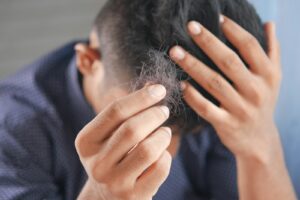Hair Shedding Solutions: Managing Thinning Hair and Hair Loss
Thinning hair and hair loss are common concerns that many individuals face at some point in their lives. Managing these issues can be challenging, but with the right solutions and care, you can address and possibly reverse the effects. This article will delve into the various aspects of hair shedding, thinning hair, and types of hair loss, providing insights into the causes and potential treatments to help you maintain healthy and luscious hair

Photo by Towfiqu barbhuiya on Unsplash
Hair Loss Overview
Understanding hair shedding and thinning is crucial in tackling the root cause of hair loss. Hair shedding is a natural process where old hair falls out to make way for new hair growth. When this cycle is disrupted, thinning hair and hair loss may occur, leading to concerns about scalp health and overall hair care.
Causes of Hair Loss
Hair loss can be triggered by various factors, including genetic predisposition, hormonal changes, medical conditions, or environmental influences. The health of the hair follicles plays a vital role in determining the amount of hair shed and the ability to regrow new hair. Understanding the underlying cause of hair loss is essential in selecting appropriate treatments and preventive measures to combat further hair thinning.
Types of Hair Loss
There are different types of hair loss that individuals may experience, such as alopecia, telogen effluvium, pattern hair loss, and female pattern hair loss. Each type presents unique characteristics and may require specific approaches for treatment. Consulting a dermatologist can help in diagnosing the type of hair loss and formulating a personalized plan to address the issue effectively.
Symptoms and Diagnosis

Photo by jurien huggins on Unsplash
Recognizing thin hair and hair shedding is essential for understanding the early signs of potential hair loss issues. Thin hair may appear limp, lack volume, and feel finer than usual due to a decrease in hair density and diameter. Hair shedding can be identified by noticing excessive hair fall during activities like washing or brushing hair. These symptoms may indicate underlying factors affecting hair health, such as nutritional deficiencies, hormonal imbalances, or stress.
Consulting a Dermatologist for Hair Loss
When dealing with persistent thinning hair or hair loss, scheduling an appointment with a dermatologist specializing in hair disorders is crucial. Dermatologists can conduct a thorough evaluation of your scalp and hair to determine the underlying causes of hair shedding. They may perform diagnostic tests to assess the health of hair follicles, identify any scalp conditions, and recommend suitable treatments or interventions based on the specific factors contributing to your hair loss.
Scalp Evaluation and Hair Thinning Assessment
During a dermatological examination, the dermatologist will assess the condition of your scalp, looking for signs of inflammation, scaling, or excess oiliness that may impact hair growth. They will also evaluate the extent of hair thinning by examining the density of hair follicles and the overall health of your scalp. This comprehensive assessment helps in determining the appropriate measures to address hair thinning effectively and restore the health of your scalp for optimal hair growth.
Treatment Options

Photo by Shiny Diamond on Pexels
Dealing with hair shedding, thinning hair, and hair loss necessitates exploring various treatment options to address these concerns effectively. Understanding the underlying causes and selecting appropriate solutions are crucial steps in managing and potentially reversing these issues. Let’s delve into some treatment options to help you maintain healthy and luscious hair.
Managing Excessive Hair Shedding
Experiencing excessive hair shedding can be distressing, but there are ways to manage this condition. Consistent scalp care, a balanced diet rich in essential nutrients, and gentle hair care practices can help strengthen hair follicles and reduce excessive shedding. Additionally, integrating hair-strengthening products or treatments recommended by dermatologists can promote healthier hair growth and minimize shedding.
Effective Treatments for Thinning Hair
When combating thinning hair, adopting treatments tailored to fortify hair strands and stimulate growth is essential. Options like minoxidil, low-level laser therapy, and hair growth medications prescribed by healthcare professionals can aid in combating hair thinning and promoting thicker, fuller hair. Proper care and maintenance routines can complement these treatments to enhance their effectiveness in revitalizing thinning hair.
Stop Hair Loss: Available Solutions
To address hair loss concerns, various solutions ranging from topical treatments, oral medications, to advanced procedures like hair transplants are available. Consulting with a dermatologist specializing in hair disorders can help determine the most suitable solution based on individual needs and the severity of hair loss. Implementing a comprehensive approach combining treatments, lifestyle modifications, and monitoring progress can contribute to halting hair loss and fostering new hair growth.
Preventive Measures

Photo by Brooke Lark on Unsplash
Preventive measures play a crucial role in combating hair shedding, thinning hair, and hair loss issues. Implementing strategies to prevent these concerns can help maintain healthy and voluminous hair. Here are some key approaches to consider:
Preventing Hair Loss in Women
Women experiencing hair loss can take proactive steps to prevent further shedding. Consulting a dermatologist specializing in hair disorders can help diagnose the underlying causes and recommend suitable treatments. Additionally, incorporating hair-strengthening products and maintaining a healthy lifestyle can promote optimal hair growth and prevent excessive hair loss.
Lifestyle Changes for Hair Thinning Prevention
Adopting healthy lifestyle habits can contribute to preventing hair thinning. Factors like managing stress levels, eating a balanced diet rich in essential nutrients, exercising regularly, and ensuring proper hair care routines can support hair health and minimize the risk of excessive shedding.
Dietary Interventions for Hair Loss Prevention
Improving your diet by including foods rich in vitamins, minerals, and proteins can help prevent hair loss. Nutrients like biotin, zinc, iron, and omega-3 fatty acids play a vital role in promoting hair growth and strengthening hair follicles. Consulting a nutritionist for personalized dietary recommendations can further enhance the effectiveness of dietary interventions in preventing hair loss.
Choosing the Right Treatment
Exploring the right treatment options is essential in addressing hair shedding, thinning hair, and hair loss effectively. By considering various treatments and personalized solutions, individuals can find suitable approaches to manage their hair concerns and promote healthy hair growth.
Considering Different Hair Loss Treatments
There are diverse treatment options available for managing hair loss, ranging from topical solutions to advanced procedures like hair transplants. Understanding the benefits and potential risks associated with each treatment can help individuals make informed decisions tailored to their specific needs and preferences.
Personalized Solutions for Excessive Hair Shedding
Personalized solutions involve customizing treatment plans based on individual factors contributing to excessive hair shedding. Dermatologists specializing in hair disorders can assess the underlying causes and recommend targeted interventions to address hair shedding effectively and promote regrowth.
Understanding Hair Loss and Hair Thinning Solutions
Enhancing understanding of hair loss and hair thinning solutions is essential for selecting the most suitable treatments. By consulting healthcare professionals and staying informed about available solutions, individuals can navigate their hair care journey with confidence and take proactive steps towards maintaining healthy and vibrant hair.
Frequently Asked Questions
What causes hair loss?
Hair loss can be caused by various factors such as genetics, hormonal changes, certain medical conditions, medications, or even stress. It can also be triggered by factors like inadequate nutrition, styling practices, or underlying health issues.
How can I deal with thinning hair?
Dealing with thinning hair involves using appropriate hair care products, following a balanced diet, managing stress levels, avoiding excessive heat styling, and seeking advice from a dermatologist for professional guidance on treatment options.
What are the types of hair loss?
There are various types of hair loss including pattern hair loss (androgenetic alopecia), telogen effluvium (temporary hair shedding), alopecia areata (autoimmune condition), and female pattern hair loss. Each type may require different treatments.
How does hair growth occur?
Hair growth is a complex process that begins in the hair follicle. It involves stages like anagen (growth phase), catagen (transition phase), and telogen (resting phase). Factors like genetics and overall health influence the growth of new hair.
Can hair shedding be prevented?
While some hair shedding is normal, excessive shedding may be a concern. To prevent excessive hair shedding, maintain a healthy diet, minimize stress, avoid harsh styling, and consider using products designed to promote healthy hair growth.
What are the common signs of hair loss in women?
Hair loss in women may present as widening of the part, noticeable thinning, increased hair shedding, or a decrease in hair density. If you notice such signs, it is advisable to consult a dermatologist for proper diagnosis and treatment.

